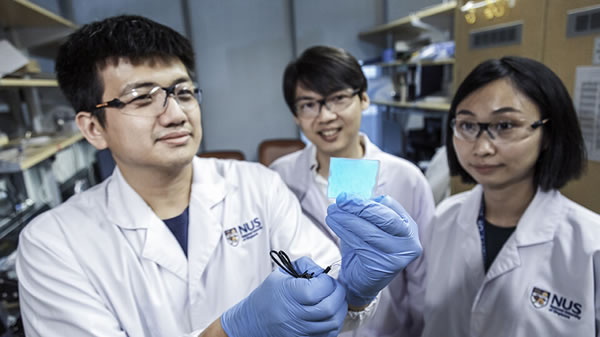Imagine a flexible digital screen that can heal itself when it breaks, or a glowing robot can find the location of a survivor in a dark, dangerous environment, or it can perform agricultural and space exploration missions. According to foreign media reports, a team of researchers at the National University of Singapore (NUS) is now turning these ideas into reality.

(Source: National University of Singapore)
When this stretchable material is used in light-emitting capacitor devices, it can achieve extremely high-visibility lighting at a low operating voltage, and because of its self-healing properties, it is not easily damaged.
This innovation is called the HELIOS device, which is a self-healing, low-field illumination, optoelectronic stretchable (Healable, Low-field Illuminating Optoelectronic Stretchable) device. The assistant professor Benjamin Tee and his team completed it in cooperation.
Assistant Professor Benjamin Tee said: "Traditional retractable optoelectronic materials require high voltage and high frequency to achieve visible brightness, limiting portability and service life. Such materials are also difficult to apply safely and quietly to human-machine interfaces."
To overcome the above challenges, researchers at the National University of Singapore began researching and testing possible solutions in 2018, and developed HELIOS a year later.
In order to reduce the electronic working conditions of scalable optoelectronic materials, the team developed a material with a high dielectric constant and self-healing properties. This material is a transparent, elastic rubber sheet made of a unique blend of fluororubber and surfactant. The high dielectric constant allows it to store more electronic charges under lower voltage conditions and has higher brightness when used in light-emitting capacitor devices.
Unlike existing retractable light-emitting capacitors, HELIOS allows the device to start at a voltage that is 4 times lower than before, but the brightness is 20 times higher. Moreover, under the condition of 2.5 V/µm, the light intensity reaches 1460 cd/m2, which is comparable to the brightness of today's mobile phone screens. It is the highest brightness that can be achieved by stretchable light-emitting capacitors.
HELIOS also has the properties of tear resistance and puncture resistance. The reversible bond between the material molecules can be broken and changed, so that it can heal itself under environmental conditions.
Professor Tee said in describing the potential impact that HELIOS can bring: "Light is an important way for humans to communicate with machines. As humans increasingly rely on machines and robots, HELIOS is used to create "invincible", durable and energy-saving light-emitting devices. Or the display screen will have great value. In the long run, it can save costs for manufacturers and consumers, reduce electronic waste and energy consumption, and enable advanced display technologies to be both cost-effective and environmentally friendly."
For example, HELIOS can be used to manufacture durable and durable wireless display screens, and can prevent damage; it can also be used as an illuminated electronic skin for self-driving soft robots, used in smart indoor farms, performing space missions, or deployed in disaster areas. This low-power, self-healing lighting skin can provide safe lighting for robots, allowing them to work in the dark and with extended working hours.
At present, the National University of Singapore team has applied for a patent for this new material and is seeking to expand the use of this technology for special packaging, safety lights, wearable devices, automotive and robotic applications. (Yu Qiuyun)
The start of the shield machine refers to a series of work in which the shield machine is driven from the tunnel door to the undisturbed soil section by using the temporarily assembled pipe segments, Reaction Frame and other equipment of the working shaft. Reinforcement of the starting end, installation of shield machine, starting bracket, assembly of shield machine, installation of reaction frame, shield machine system debugging.
Starting Frame,Shield Launching Frame,Shield Starting Base Structure,Starting Base Frame
Anshan Lijian Engineering Group Co. LTD , https://www.lijianformwork.com